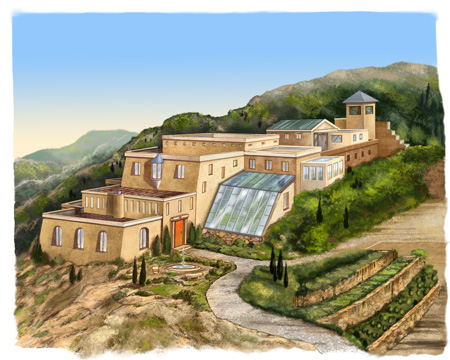The House that Enlil Built, part 2
by Anthimia Kaltagiron
Ortolana month, AC 228
Enlil was more socially conservative than most people gave him credit for, and he kept the partying to a minimum when he was there. He invited sedate groups of older women and a few of their menfolk for classes on nouetic matters, held in his living room in front of the warmth of a big stone fireplace, and they paid well for access to the Master and his wisdom, not to mention his celebrity status. Members of his entourage who were part of the more permanent crew remember long nights full of history lectures and discussions, since Enlil was constantly working on his forty-year project, the "Nouergic History." Late in the evening, the Master would go up the stairs and retire to his private apartment, though those closest to him knew that he had a surveillance system to warn him if things went too wrong.
In fact, Enlil was there at Acragas, whether he was physically present or not. What most of the part time residents, caretakers, students, or hangers-on did not know was that Enlil, a master artist at retained effects, had filled Theophore House with hidden esoteric devices. During the building of the main house, which was supported not with wood but with a framework of iron girders, Enlil supposedly placed a massive nouergic "charge" into the metalwork, immensely energized by his attracting a lightning strike on the structure. The combination of earthly electricity with nouergic force, if indeed it was done, was something which only Enlil's audacity would attempt.
In addition to the reservoir of energy in the framework, Enlil incorporated nouergic sensors into walls and furniture, including the outbuildings. These were used mostly as warning devices. Nouergic students are not in as much control of their powers as the master, and experimental accidents can happen at any time. These sensors would alert Enlil in case something was going wrong. He may have also used them as spy devices, especially in his middle and later years, when he had become a politically controversial figure.
Theophore House served him as a refuge and a place of recovery after the dreadful events in 217, when he was captured (with a tranquilizer dart) and imprisoned in Eridu, accused of plotting to overthrow the government. He was indeed associated with some people who were in such a plot. His role with them was unclear, but everyone who knew him knew that he had long despised Eridu, openly calling its government oppressive and unjust. Saved by a coalition of his nouergic and political allies, Enlil retired from public life into retreat in Acragas. He felt more than ever the need for protection, and his nouergic art was the only thing he trusted. And so he built up even more layers of defenses, which were only discovered after he was no longer in the physical world.
The ownership of Theophore House was immediately in dispute after Enlil was legally declared dead rather than disappeared (a decision which was in itself controversial). Enlil left this world without creating a clear will and testament; he had often said that like the ascetics of the Old World, he had no property and everything he had was lent to him by other people. In the confusion, the house passed to his Lord of Memory relatives from his clan Lil, who had been taking care of it already.
"Taking care" was, however, a poor descriptor of what was going on. His relatives and their friends and guests had become squatters in the building, without doing any maintenance on it. Visitors reported back to Enlil's associates at Surakosai that conditions at Theophore House were chaotic. There was still no clear legal claim to ownership, and this eventually resulted in a complicated legal case which dragged on for two years.
Meanwhile, things were getting worse at Theophore House. There were reports of bizarre behavior among the "residents," including sudden attacks of panic, hallucinations, and outbursts of irrational anger. Finally, in the winter of 227, the Keilian constables of Acragas were called to the scene, and they found that the worst (and perhaps inevitable) had occurred: there had been a murder in Theophore House. According to the suddenly sober inhabitants, the story went as follows. They had run out of money and could not afford to pay for electric power any more. The heating system, which was never very good, had quit and they were freezing. They were finally forced to break up some of the furniture to burn in the fireplace. While this was happening, one of the couples living there got into a violent argument. The female claimed that while she was sleeping in what used to be Enlil's bedroom, Enlil himself had visited her and had sex with her. Never mind that Enlil was, so to say, permanently absent; her partner believed her and immediately became enraged at her infidelity, a peculiar attitude in a polyamorous household. The argument escalated and finally the male picked up the broken-off leg of a table and bludgeoned his "unfaithful" partner with it until she was unconscious. By the time the police arrived, she was dead.
This incident was enough to get all the squatters, who were mostly Lords of Memory, deported to their own territory near Rhakoteh, where the complexity of Lord of Memory justice could do its work. Now, Theophore House was abandoned to the elements and the creatures of the cliffs and air. Meanwhile, over the decades, the area around Theophore House and its land had been populated with expensive vacation villas and private resorts. The location, especially with its private seaside access, had become valuable, and developers regularly inquired as to whether it was available for sale. The problem was that no one was clearly entitled to sell it. With the crime, though, Enlil's Lord of Memory clan Lil had essentially forfeited its right to occupy the house and its lands.
During last year, attempts were made by the Nouergic Institute of Surakosai to enter the house and grounds in Acragas. The best legal opinions were that since Enlil had presided at the Institute, and that his original intentions were to turn it into a satellite nouergic institute connected with Surakosai, the place belonged to the Surakosans. But after the abandonment, Theophore House had become a liability rather than an asset. Keilian workers who were sent in to at least clear the debris refused to work there after a few days. Other Keilian workers could only work there if they were drunk, which didn't make for good work habits. Finally the Keilian labor force from Acragas and environs said that they would not work there under any circumstances, because the place was haunted.
The word "haunted" refers to the superstitions of the Keilians, who believe in non-physical conscious entities which can interact with people. The workers reported the same thing that the previous residents did: unexplained fits of panic, sudden almost suicidal melancholy, attacks of mania, and hallucinations. Finally a nouergist of modest status named Antiochus was hired, by the Surakosan Institute, to make an investigation. He lasted one week there before he quit. But his report to the nouergic leadership at the Surakosai Institute gave them the evidence they needed to explain what was going on. Enlil had filled the house with defensive retained effects, of a specially insidious variety known as "artificial intelligence retained effects." And these were now, after many years, degenerating and going out of control.
TO BE CONTINUED
Another, annotated view of Theophore House, this time from the west side looking eastwards.

A larger version of this image can be found here.
Posted at 3:02 am | link
The House that Enlil Built, Part 1
by Anthimia Kaltagiron
Anthimia month, AC 228

Last month, "Theophore House," in Acragas, was demolished. It wasn't just torn down, but the entire landscape where it had existed was re-made, with a radical combination of nouergic and conventional deconstruction techniques. Some onlookers, who know the history of the site, commented that the destruction almost seemed like an act of anger or revenge, rather than just a removal for new building on the site. When it comes to Enlil and his legacy, anything is possible. It was often said about Enlil that wherever he went, he brought with him chaos and upheaval. "Theophore House" was no exception.
Enlil's arrival in Acragas, in 172, was not a planned move. It was the result of what might be politely called "career confusion." He had been an adjunct professor at the famous Historikon in Eridu, but had been released due to several reasons, one of which was the unease of the other faculty at the presence of a working Nouergist, endowed with mysterious and disruptive powers. Enlil had not been able to find further academic work, and this was made even more difficult when Enlil participated in the production of a low-budget action film, something he had (in typical Enlil fashion) just happened upon while avoiding the lectures at a conference on the Rhakoteh coast. Shortly after that, he was recruited to teach history and nouetics at a small new institution being founded in the town of Acragas, and there he went.
In the early seventies of the previous century, Acragas wasn't the rich resort town it is now. It was a Keilian fishing village which had become home to a community of rejects, misfits, oddities, and people with what could politely be called "pasts." There were rumors that the unofficial leader of the community, an Eridanian Algon named Tashi who ran the bar and restaurant on the main square, had shot a man dead in a sex and spy scandal and fled Eridu for the rugged North. There were cultists, alcoholic artists, eccentric scientists with unproven theories, and visionaries of various sorts. It was a place where Enlil would fit right in.
The southwest coast of our Trinacria was in those days still almost entirely undeveloped. Keilian fishermen, loggers, and trappers had some settlements there, and wandered through the forests and rocky slopes, but there were no immigrant residences, and none of the ultra-expensive vacation estates and resorts which now populate the "Coast of Warmth," as the advertisers have named it. It was easy for Enlil, with some backing from his friends and his financially successful sister Ninlil, to acquire a fairly large number of hectares of coastal land for building what Enlil hoped would eventually become a "Theophoric Institute."
He recruited his own mentor, the Nouergic architect Apsou-Ari, to help him with the project design. She was well-connected in Trinacria, having built the "Crystal City" towers in Surakosai in the previous decade. Even though Apsou was then the head of state in Eridu, she managed to contribute architectural designs and even made a couple of brief visits to supervise the construction, which broke ground in 173.
By the next year, though, Apsou was off the project, not only because of obvious time constraints, but because her presence had brought unwanted attention to Acragas (which hosted not just Tashi, but many exiles and rejects from Eridu). And even more, Enlil wanted to continue the design work himself, even though he was not trained as an architect. Architectural historians who reverently chronicle Apsou-ari's work refuse to consider "Theophore House" authentic Apsou, because of Enlil's re-designs. According to the Khemaru, Mereth Kahn, currently the only Nouergist working as an architect, Enlil's modifications returned the house to the blocky, squarish and somewhat crude lines of Keilian vernacular, rather than the more graceful forms that Apsou had envisioned.
The house was finished in 175, and named "Windhaven," a name which quickly devolved simply to "Theophore House." But as soon as Enlil occupied it, he was called to Surakosai to serve as the Eridanian consul. Throughout the next forty years, Enlil would be only a part-time occupant, commuting back and forth to Acragas from wherever he was stationed. He would teach, on an irregular schedule, at the University of Surakosai as well as doing guest semesters elsewhere. As the years went on, he and his students and assistants built additions onto the house. The seaside sprawl included a courtyard, a laboratory for biological and nouergic investigations, a glassed-in winter garden, and even, at one point, a chicken coop. His more agriculturally minded students built terraces for vegetable gardens, and the athletically inclined built a stamat game court which also served as a landing platform for small liftcraft.
Theophore House at its best, around 200 A.C.

For a larger version of this image, go here.
Over the years, there wasn't anyone in the nouergic community, it seems, who didn't visit Theophore House one time or another. Enlil had guest cottages built lower on the property, to accommodate sensitive types who needed a nouetically isolated environment. At any time, whether Enlil was there or not, someone or a group of someones populated the house. An informal group of his students and a few of his Lord of Memory relatives kept the place active and hospitable. When the master was there, he indicated his presence by flying an orange banner from a metal pole fixed on the topmost roof level.
TO BE CONTINUED
Posted at 12:02 am | link
Archives:
October 2011 (1)
September 2011 (1)
September 2010 (1)
July 2010 (2)
June 2010 (1)
May 2010 (2)
April 2010 (14)
March 2010 (3)
June 2009 (1)
May 2009 (1)
April 2009 (3)
March 2009 (2)
February 2009 (4)
January 2009 (4)
August 2008 (1)
April 2008 (2)
March 2008 (2)
February 2008 (4)